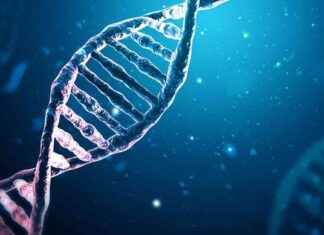The Tasmanian tiger has been thought to be extinct for decades. But researchers believe it is possible to bring the extinct tiger back to life using genetic engineering. For this, the closest living relative of the animal is sought. The result surprises.
The canine creature nervously paces back and forth in its small cage. The rear part of the back is decorated with long, dark stripes. The long snout sniffs a man standing in front of the close-meshed fence. The 1935 black and white video shows “Benjamin”, the last known Tasmanian tiger. “It was driven out of its natural habitat by the advance of civilization,” says a spokesman. Just one year later, the unusual animal died at the Beaumaris Zoo in Tasmania’s capital, Hobart.
For decades, the species, also known as the “bag wolf” and native only to Australia, has been officially considered extinct. But researchers now think it’s possible to bring the Tasmanian tiger (Thylacinus cynocephalus) back to life. “15 years ago the idea of ??actually bringing the animal back was still science fiction,” said Andrew Pask of the University of Melbourne. The technology used in the project was not yet available at the time. Pask directs the newly established “TIGRR Lab” (Thylacine Integrated Genetic Restoration Research).
It is a laborious undertaking: the researchers first had to decipher the genome of a Tasmanian tiger that had been preserved in alcohol for 100 years. In 2018, Professor Pask’s team published the first complete genome sequence of the animal. Tasmanian tigers were also once found in mainland Australia and New Guinea. Around 2000 to 3000 years ago, the animal that competed with the dingo and was hunted by humans disappeared there. But in isolated Tasmania, thylacines were able to survive – until Europeans settled the island in the 18th century.
The predator, known as a sheep killer, was hunted to extinction, and the government even gave a reward for each specimen shot. With the deciphered genome sequence, the TIGRR Lab is only at the beginning of its mammoth project. “We can’t create life from a dead specimen. We always have to start with something alive,” explains Pask. That is why such projects, which are known as de-extinction in English, search for the closest living relative of the extinct animal. In the case of the Tasmanian tiger, the choice was – somewhat surprising for laypeople – the thick-tailed narrow-footed pouch mouse.
It is also endemic to the fifth continent, i.e. only distributed there. The mouse’s DNA is altered or “edited” until it matches the Tasmanian tiger’s genetic code. ‘We essentially rebuild our mouse genome into Thylacine code in a living cell,’ says Professor Pask. If the team succeeds, cloning technology could be used to create a whole thylacine embryo that would then be carried to term by the narrow-footed thylacine mouse, which is only about four inches tall. “One of the great things about marsupials is that they give birth to tiny babies,” says Pask. Tasmanian tiger babies are about the size of a grain of rice at birth. Thus, a mouse can carry the baby of a Tasmanian tiger.
The young would then be raised in the laboratory, after which the predator – if all goes well – will be released back into its natural habitat in Tasmania. “Part of our mission is to right the wrongs that were committed in the extermination of the thylacine by humans alone,” said Ben Lamm, founder and CEO of Texas-based biotech company Colossal Biosciences. The US company specializes in “de-extinction” and collaborates with the TIGRR Lab from Melbourne. “Colossal is providing computational biology and genetic engineering support to the project and is working on a long-term plan for its release,” Lamm said. The company has a financial stake of ten million dollars in the project. The project received millions in donations from private investors, including the Australian actors and brothers Luke and Chris Hemsworth (“Thor”, “Snow White and the Huntsman”).
Some scientists doubt that the project can succeed. “I still don’t think we have anywhere near the technology to actually recreate an extinct animal,” Professor Jeremy Austin of the Australian Center for Ancient DNA told the Sydney Morning Herald. De-Extinction is a “fairytale science”. It’s more about publicity for the researchers involved. “For WWF Germany, such genetic engineering projects do not represent a way out of the biodiversity crisis,” says species protection expert Anne Hanschke. Something like that costs a lot of money and it is more important to eliminate the causes of species extinction, such as the destruction of habitats, the overexploitation of nature or the climate crisis. “In addition, there is a bit of a risk of not taking the necessary steps to conserve species now – because you can “recreate” them later if necessary,” adds Hanschke.
Ultimately, even if it were possible to create such an animal, it is very uncertain whether it would exhibit the same behaviors – such as behavior normally learned from conspecifics – and could occupy the same ecological niche as its predecessors. In any case, TIGRR Lab believes that in five to ten years it will have produced a living cell with thylacine code. But it’s not just about a single species: The methods should also help animal species that are threatened with extinction today: “We now do biobanking. That means we collect tissue and cells from animals from wild populations and freeze them.”
Using this database, for example, koalas, which are now considered endangered due to forest fires and loss of habitat, could be recreated in the event of their extinction. In view of Australia’s climate challenges, this could become essential, says Pask. ‘If we don’t step in and start doing this kind of work and genome engineering, we’re going to lose biodiversity even faster than we’re already doing,’ he says.
(This article was first published on Tuesday, November 01, 2022.)






